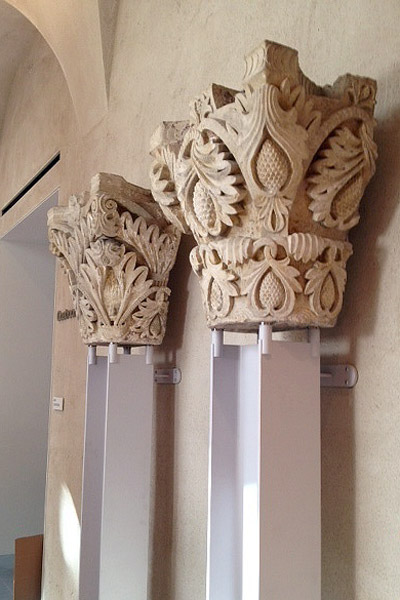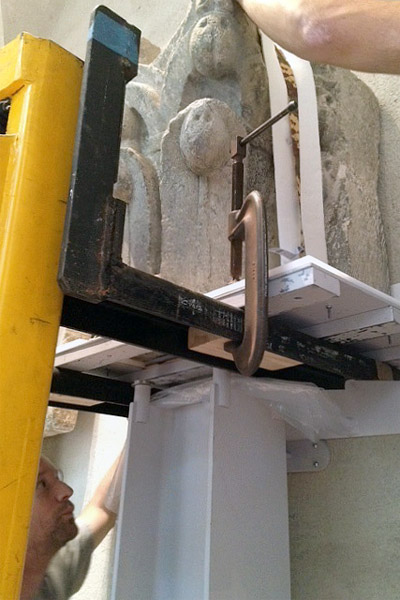Visitors who enter the renovated Harvard Art Museums will find much that has been transformed. Yet familiar faces abound, too. Eight of the museums’ beloved medieval capitals, traditionally displayed around the Calderwood Courtyard, are again mounted along the walls of that space. This time, though, they’re being shown in a new light (literally), as they sit underneath the gleaming glass ceiling. New pedestals for the capitals, designed by architect Renzo Piano, add another breath of fresh air.
The installation of the capitals was complex. The 12th-century objects from France and Spain (such as the Capital of Engaged Twin Columns from Santa María de Lebanza, Palencia) had originally been installed decades ago—meaning nobody on today’s staff had witnessed it. In terms of institutional knowledge about how to move the works, “we were essentially starting from scratch,” said Jon Roll, senior collections specialist.
After the museums closed for renovation in 2008, the capitals were transported out of the courtyard by forklifts. Each was brought to the Straus Center for Conservation and Technical Studies for examination. Among the findings: the capitals are relatively flat on the bottom—a helpful detail. Another essential: most weigh close to 1,000 pounds apiece, with two weighing in closer to 1,200 pounds each.
The collections management team, led by Exhibitions Production Manager Karen Gausch, tested potential reinstallation scenarios by using foam mockups. All of this strategizing kicked off when Renzo Piano decided on a pedestal design: six-foot-tall painted steel I-beams, each featuring four small support pads at the top. “We experimented many times, with different heights of I-beams,” Gausch said.
The team spent two weeks in August setting the capitals on “shorty” pedestals, determining exactly how each would be supported. “The tests were huge,” said David Glaser, one of the museums’ art installers. “They revealed everything we needed to know,” including where the center of gravity lay in each object, and the height to which every two-inch support pad needed to be raised. Besides being held by the four pads on each pedestal (and assisted by gravity), each capital would receive extra support from steel arms mounted on the wall above.
The testing helped allay concerns that something could go wrong (scratching the floors, or worse, injuring a team member). “When you’re moving something so big, there’s so much choreography involved,” Gausch said.
When it was time for installation, the team benefited from the efficient work of the construction firm Diamond Steel, which drilled holes and secured the wall mounts just before the capitals were lifted.
Each capital was strapped onto a two-piece steel pallet with four holes in the middle. The holes corresponded to the four pads on each pedestal. Using a forklift, the pallet and capital were placed on the pads. Each pad’s height was carefully adjusted (by screwing the pads up or down from below) so that the weight of the capital was evenly distributed. The capital was also secured via the safeguard mount above the capital. Then, the pallet pieces were separated and removed, leaving the heavy stone art to stand freely—seemingly effortlessly—on the I-beam.
Using this method, the team was able to install all eight capitals within four days. Many years of careful planning swiftly came to a close, and the capitals were ready for a new life in a revitalized space.





